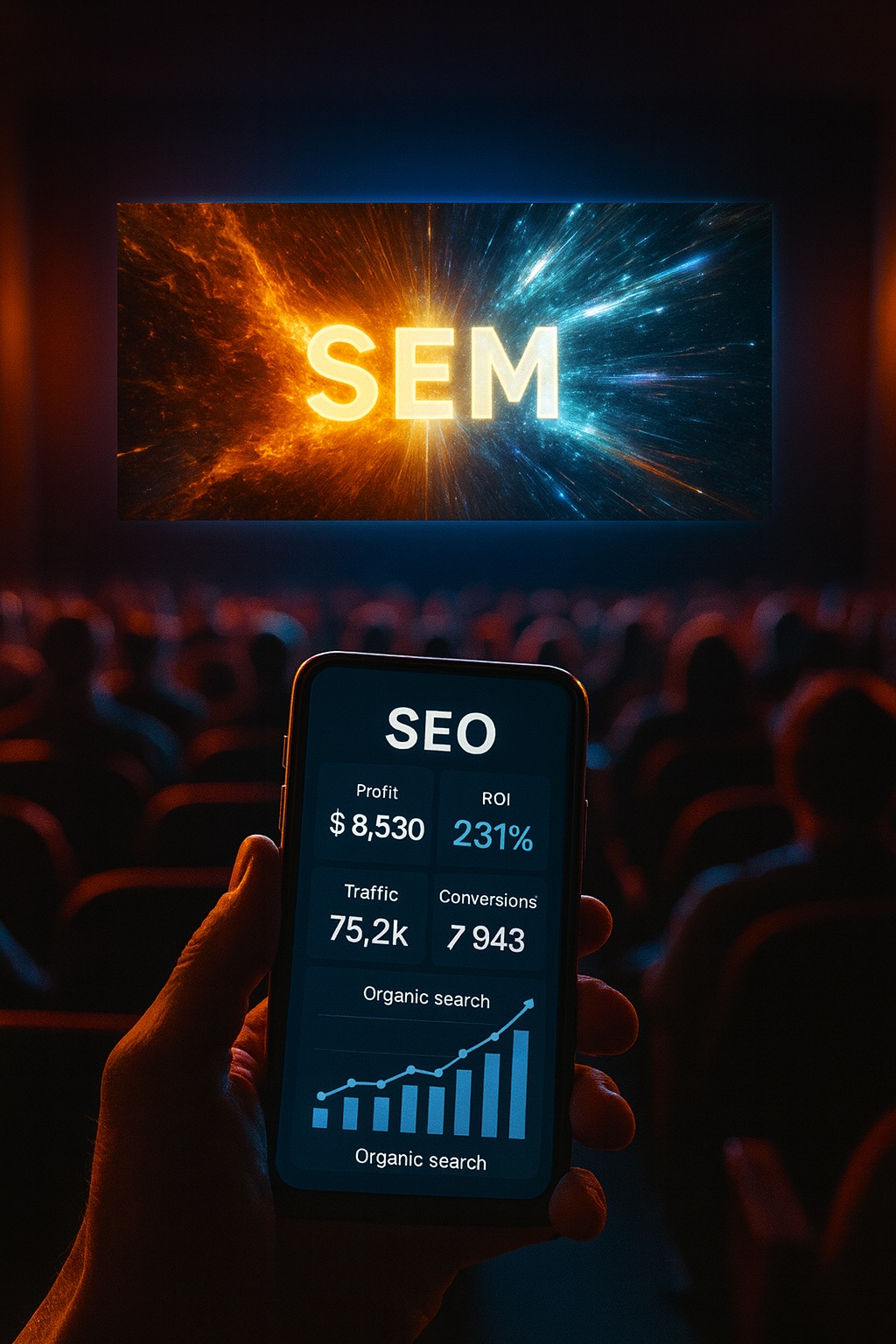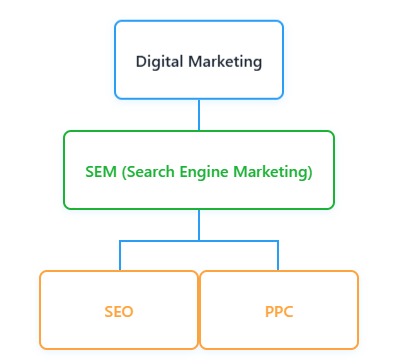What’s The Difference Between SEO and SEM?
The difference between SEM and SEO is that SEO is the branch of Search Engine Marketing (SEM) that deals with optimization. Optimization is just one part of marketing; therefor, SEO is just one part of SEM. The difference is where each one stands on the marketing hierarchy: SEO is optimization for the purpose of marketing — SEM is the marketing itself. Without SEM you couldn’t have SEO, and without SEO, SEM is incomplete.
All marketing strategies require some sort of optimization if they are going to yield expected results; otherwise, it’s a blind strategy. Optimization is part of the marketing, not the marketing itself. The real difference between SEM and SEO is, quite literally, one word.
- SEM: Search Engine Marketing
- SEO: Search Engine Optimization
The Difference Between SEO and SEM
Digital Marketing
Digital marketing encompasses all online marketing efforts used to promote products or services through digital channels. This includes Search Engine Marketing (SEM).
SEM (Search Engine Marketing)
SEM is a subset of digital marketing that focuses specifically on increasing visibility in search engine results pages (SERPs). Here’s the key distinction: SEM includes both paid and organic search strategies. While many people confuse SEO and SEM, SEM is actually the broader category that encompasses both SEO (organic search optimization) and PPC (paid search advertising). SEM represents a comprehensive search marketing approach.
SEO (Search Engine Optimization)
SEO is the organic component of SEM. It involves optimizing your website and content to rank naturally in search results without paying for placement. SEO focuses on content creation, technical website optimization, and building authority through quality backlinks. While SEO is part of SEM, it’s specifically the unpaid, long-term strategy that builds sustainable search visibility over time.
PPC (Pay-Per-Click)
PPC is the paid component of SEM. It involves creating and managing paid advertisements that appear in search results, where you pay each time someone clicks your ad. PPC provides immediate visibility and can be precisely targeted, but requires ongoing investment. Combined with SEO, PPC completes the full SEM strategy, giving businesses both immediate paid results and long-term organic growth.
A Deeper Dive Into SEM
Search Engine Marketing (SEM) is a process to rank on search engines like Google. Google captures around 80% of the global search engine market. The websites that rank on Google’s first page get the bulk of search engine clicks. There are two ways to rank on the first page of Google:
- Organic: Earn a ranking position on search engines through Search Engine Optimization (SEO)
- Paid: Buy into a ranking position and become sponsored — Google Ads (paid advertising like PPC)
When both paid and organic component are used together, it’s considered SEM. In other words, SEM completes Search Engine Optimization (SEO) and can make an SEO campaign even more effective.
SEM is when you use SEO and Google Ads (Paid advertising) together.
Does SEM Accelerate SEO Results?
Absolutely. Search Engine Marketing (SEM) uses both Paid advertising and SEO, providing a full-fledged marketing solution. Paid advertising like PPC allows website to rank on Google’s first page immediately, driving website traffic and increasing revenue fast. On the other hand, SEO works to build organic ranking, providing a more sustainable search engine presence. The nature of these two compliment one another. Data is gathered from Google Ads relatively quickly, and this data can be used to accelerate SEO results; therefor, paid ads can get leads quickly while also providing data that can be used to create a more successful SEO campaign.
* First-party Data for PPC is more important than ever and can be used to drive better SEM results.
SEO vs SEM comparison
SEO earns visibility without paying per click. Google Ads buys visibility without needing to wait. SEM is the combined strategy using both—fast wins from Google Ads and long-term gains from SEO.
| Area | SEO (organic) | Google Ads (paid search) |
|---|---|---|
| Ranking speed | Months for increased website traffic. | Live in hours, immediate traffic. |
| Cost model | Upfront or monthly costs based on SEO features. | Pay-per-click + management; cost stops when ads stop. |
| Control | Ranking positions vary and influenced by content quality. | Set budgets and targeting placement. |
| Durability | An asset: Rankings last and builds authority. | An expense: Ranking stops immediately when ad funding stops. |
| Data feedback | Organic search traffic, pages, and ranking keywords + site behavior from content. | Real-time performance metrics, conversion tracking, and audience behavior data. |
| Best use | Growing traffic overtime, lowering cost per lead, building trust and authority in industry. | Quick sales, product launches, seasonal campaigns, market tests. |
When to use more SEOlong-term
If you need traffic that lasts and keeps getting cheaper over time, prioritize SEO while Google Ads covers gaps.
- Create helpful pages that answer customer questions.
- Rank for core industry keywords that drive buyers.
- Fix technical issues so your site is easy for Google to index.
When to use more Google Adsright now
If you need results fast or want to test offers before investing in content, lean on Google Ads while SEO ramps up.
- Run campaigns on high-intent keywords for immediate leads.
- Test messages and promotions before scaling SEO content.
- Target time-sensitive campaigns or competitive terms.
Not sure which SEM strategy is best for you?
take our SEO vs PPC quiz and discover which Search Engine Marketing strategy will work better for your business.
How SEO and SEM Work Together
Since SEM includes both components of Search Engine Marketing—SEO and Google Ads—SEO alone means missing out on the growth factors provided by Google Ads, and vice versa.
For example, the time required to rank organically through SEO means lost opportunities as businesses could be generating immediate profit from conversions through Google Ads, even while SEO is being established.
On the other hand, The only thing keeping immediate visibility in tact through Google Ads is Ad spend. For PPC, this means paying for every click regardless of whether the person who clicks purchases anything or not. By including SEO with Paid ads, it can effectively rank websites for keywords organically. This means less reliance on Ads and more foundational growth that gets clicks organically.
When you rank for keywords organically, you no longer have to pay for every click. You can reduce your cost-per-click and increase your ROI, or direct that spend to target keywords for new market entrance.
Why You Should Use Both SEO and SEM
SEM is both SEO and Google Ads. Google Ads without SEO and SEO without Google Ads is incomplete Search Engine Marketing. The highest results are generally achieved with both.
| Area | Only SEO | Only Ads | What You Get From Combining Both |
|---|---|---|---|
| Speed | Rankings take months to build. | Traffic stops when ads stop. | Ads give fast data that helps SEO grow quicker. |
| Cost | High early cost, slower payoff. | Pay every click, margins shrink. | Lower Cost per lead over time—PPC funds early growth, SEO compounds. |
| Control | Rankings depend on Google’s algorithm. | Ad costs rise with competition. | PPC gives control, SEO gives stability. |
| Durability | SEO compounds but can plateau. | No lasting value once ads stop. | SEO builds a base, PPC fills gaps. |
| Data | Slower testing and insights. | Fast data but poor long-term site value. | Ads test fast, SEO makes results permanent. |






